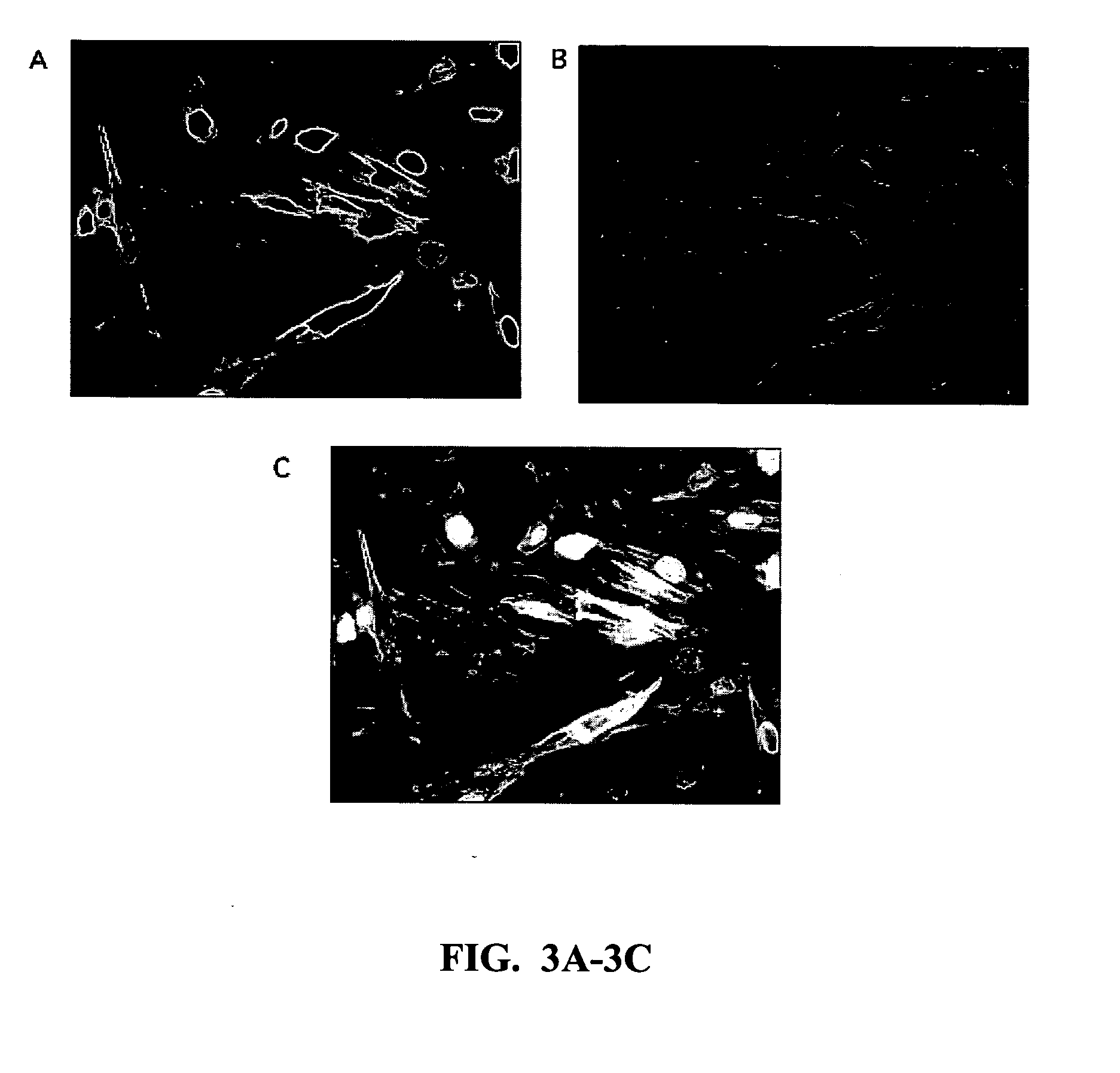Methods and compositions related to 1-caldesmon
a technology of caldesmon and composition, applied in the field of gene therapy and infectious diseases, can solve the problems of reducing cell adhesion, affecting cell membrane function, cell membrane integrity and barrier function, and no antiviral therapy available, and achieves the effects of reducing toxicity, reducing cell toxicity, and low transfection efficiency
- Summary
- Abstract
- Description
- Claims
- Application Information
AI Technical Summary
Benefits of technology
Problems solved by technology
Method used
Image
Examples
example 1
Materials and Methods
[0169] Cell Culture
[0170] Cultured UMNSAH / DF-1 cells (DF-1) were purchased from American Type Culture Collection (ATTC). All cells were grown in Dulbecco's modified Eagle's medium with 10% fetal bovine serum at 39° C. and 5% CO2. Vitrogen collagen (Type 1, bovine dermal collagen) was obtained from Celtrix Pharmaceuticals Inc. (Santa Clara, Calif.). Microelectrodes were obtained from Applied Biophysics Inc. (Troy, N.Y.), and anti-caldesmon antibody was purchased from Transduction Laboratories Inc. (LaJolla, Calif.). Oligonucleotide primers were synthesized by IDT-Technologies, Inc (Coraville, Iowa). Texas Red phalloidin and Oregon Green anti-mouse antibodies were purchased from Molecular Probes (Eugene, Oreg.). Cultured human umbilical vein endothelial cells (HUVEC) were prepared by collagenase treatment of freshly obtained human umbilical veins as previously described (Carson et al., 1989). All cells were cultured in Medium 199 (Gibco) and supplemented with 20...
example 2
Results
[0181] 1-CaD Co-Localizes with Microfilaments
[0182] Images containing Oregon Green-labeled 1-CaD filaments were assigned a green pseudocolor using Adobe Photo Shop, while images containing Texas Red labeled actin filaments were assigned a magenta pseudocolor. Images of green and magenta filters were registered, and co-localization of 1-CaD to the actin cytoskeleton was determined by the resulting formation of white or lighter-magenta colored filaments.
[0183] In vitro Wound Closure Assay to Measure Cell Motility
[0184] DF-1 cell motility was measured by wounding the cell monolayer and measuring wound closure by monitoring the traversed distance over time. DF-1 cells were plated at 70% confluence on glass cover slips coated with 100 μg / ml of fibronectin. These cells were then transfected with Ad-CaD or Ad-empty and allowed to grow to 100% confluence (2 days post-transfection). A wound was made in the monolayer using a sterile pipette tip with an outer diameter of 300 μm. The...
example 3
Lentiviral 1-CaD
[0221] The following studies examine how other caldesmon mutants may alter cell membrane integrity in DF-1 cells and in mammalian cells. Recombinant-deficient lentivirus is used instead of an adenovirus-deficient delivery system. The carboxyl terminal half of caldesmon (CaD39) is shown to protect endothelial cell membrane and the mutant, CaDS504 / 534E, also exhibited protective effects on cell-membrane properties in endothelial and fibroblast cells.
[0222] Generating molecular constructs of wild-type and mutant CaD: The cDNA for HUVEC 1-CaD was cloned by RT-PCR, subcloned into an adenovirus expression vector and transfected into DF-1 cells, which are null for CaD. The impact of heterologous expression of wild-type CaD on transcellular resistance in DF-1 cells was evaluated. Protocols were developed to carefully control for transfection efficiency and protein localization. Protocols were also developed that measure transcellular impedance in which the inventors correc...
PUM
| Property | Measurement | Unit |
|---|---|---|
| frequency | aaaaa | aaaaa |
| frequency | aaaaa | aaaaa |
| frequency | aaaaa | aaaaa |
Abstract
Description
Claims
Application Information
 Login to View More
Login to View More - R&D
- Intellectual Property
- Life Sciences
- Materials
- Tech Scout
- Unparalleled Data Quality
- Higher Quality Content
- 60% Fewer Hallucinations
Browse by: Latest US Patents, China's latest patents, Technical Efficacy Thesaurus, Application Domain, Technology Topic, Popular Technical Reports.
© 2025 PatSnap. All rights reserved.Legal|Privacy policy|Modern Slavery Act Transparency Statement|Sitemap|About US| Contact US: help@patsnap.com



